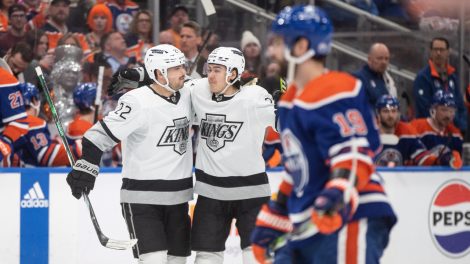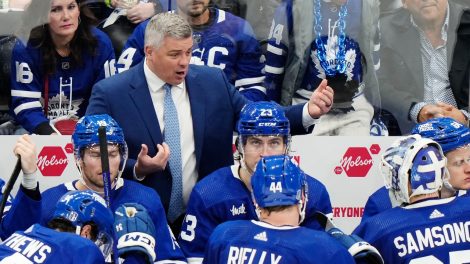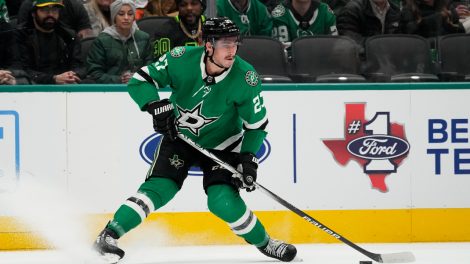Seven National Hockey League debuts and 50 American Hockey League losses later, the Manitoba Moose have a summer to take stock of an eventful season back in Winnipeg.
It was that kind of year for the Moose, the Winnipeg Jets’ AHL affiliate. The Jets relocated their AHL franchise to Winnipeg for the start of the 2015-16 campaign, bringing the AHL back to the city for the first time since the NHL’s return in 2011.
Moving the franchise from St. John’s to Winnipeg provided several perks. Along with far easier travel and logistics for sending players to and from the farm team, Jets management could easily keep a close eye on their prospects at MTS Centre.
“[Jets general manager Kevin Cheveldayoff] can walk out of his office [to watch the prospects] instead of flying seven hours,” Jets assistant GM Craig Heisinger said.
Winnipeg prospects also had an opportunity to train at an NHL-calibre practice facility and gain plenty of access to and face time with Jets management and training staff.
Local fans certainly responded — the Moose finished ninth in league attendance with a stout 7,285 average despite the team’s on-ice woes.
But with any change comes a learning curve, and the Moose were no exception — despite the experience of a management group that had come up through the AHL ranks.
The other side:
Before the Jets arrived, True North Sports & Entertainment had spent 10 seasons on the AHL side of the hockey business as the Vancouver Canucks’ affiliate. Bringing the NHL back to Winnipeg meant that TNSE learned the business from the NHL perspective.
Now they are firmly on both sides of the divide from an on- and off-ice point of view.
Putting the AHL back in Winnipeg and making the Moose a co-tenant with the Jets afforded the management group the up-close challenge of trying to strike the fine balance between their prime goal of player development – and finally having enough prospects to go all-in with that approach – and creating the type of winning atmosphere that can provide a stable, upbeat environment for players barely into their twenties.
That development-versus-winning question is something that is a much-debated issue — one that will likely never find a consensus among different management groups. But all things being equal, many NHL clubs will shell out significant salaries to AHL veterans in order to cushion the learning curve that young prospects endure generally.
As the Moose experienced this season, keeping the mood positive in a dressing room when a collection of young prospects loses 50 games can be a challenge.
Marrying those goals of development and winning is part of Heisinger’s job description. One thing is for sure, and that is that the Moose will continue to play a significant role in the organization’s strong focus on a draft-and-develop strategy.
“Winning is an important part of development,” Heisinger said. “You’ve got to find that line in the sand. You’ve got to support the young guys, but you’ve got to make sure that they get the ice time, that they’re given a chance to succeed and move forward.”
“It’s hard because everybody wants to win. But success and winning in the end is going to be measured by how the Jets do, and the Moose are a huge part of that. You need to learn to win, and you need to learn to lose as you come up, but they need to be ready to win when they get to [the NHL].”
“You’re trying to do what’s best for the Jets and have a competitive team for the Moose.”
It has already been a busy off-season in Manitoba. The Jets elected to not renew the contract of Moose head coach Keith McCambridge after five seasons. Heisinger declined to delve into the reasoning behind the decision and did not have a timeline for when a new coach will be hired for what is considered one of the top head-coaching jobs in the AHL because of the resources and fan support that accompany it.
“There is no urgency to get that position filled,” Heisinger said.
The bad:
The Moose started the season with one win in their first nine games. They spent a significant part of the season in last place overall in the AHL before eventually finishing 28th.
What followed sometimes veered into the ugly.
Along the way, the Moose endured a nine-game losing streak and a stretch in which they lost 17 of 20 games. In one three-game mid-season period, they allowed 47 or more shots in three consecutive games. A six-game road trip included 8-2 and 9-0 losses.
Several key veterans that had been counted on at the started of the season sustained significant injuries and/or failed to produce. Veteran Thomas Raffl went through a dislocated collarbone, and other injuries before January. Eventually the Moose shut him down for the season because of an unrelated lower-body injury.
Winger Matt Fraser, who twice had been a 30-goal scorer with the Texas Stars, managed all of five goals in 44 games before he was shipped off to the Chicago Blackhawks. Veteran NHL defenceman Jay Harrison also departed with Fraser after being held to 18 games due to a variety of injuries.
“Where the line between winning and development [is], it probably wasn’t as even as it should have been,” Heisinger acknowledged. “But I can’t say that we knew exactly how it would play out either. I think we thought we had a better team when the season started, personnel-wise, than we played.”
“I don’t think there are excuses for the lack of success. I just think that there are reasons for the lack of [success] that unless you’re on the inside you can’t understand.”
Sticking to the plan:
Part of the adjustment was finally having an influx of young players to inject into the developmental pipeline. Winnipeg management inherited a weak collection of prospects in 2011, and Heisinger said it took several years to begin cycling Winnipeg-selected draft picks and prospects into the developmental chain.
With those prospects now on hand, the Jets made a concerted effort to stick with their youth no matter what.
“It wasn’t just wins and losses for us,” Heisinger explained. “There was a learning curve on the management side, too. There was a conscious effort made to make sure that all of the young players played no matter what – turnovers, mistakes, bad penalties, they went back over the boards.”
Through it all, even as the defeats piled up and the Moose continued their descent in the AHL standings, Heisinger stated that there was no temptation to stray from that commitment from their prospects.
“There is the odd time where it is really tough, but I wouldn’t say that there was any time [there was a temptation to stray from draft-and develop],” Heisinger said.
Bright spots emerge:
Management’s patience did start to pay off eventually.
Along with the six NHL debuts for Moose players, several key prospects prospered. Goaltender Connor Hellebuyck sandwiched 26 games with the Jets between two AHL stints amounting to 30 games.
Rookie netminder Eric Comrie took over the Manitoba net in Hellebuyck’s absence and sparkled. The second-round pick in the 2013 NHL Draft blended a calm, composed personality far beyond his 20 years with some excellent goaltending. Despite facing a barrage of shots on most nights, Comrie played 46 games (fifth-most in the AHL) and managed a .907 save percentage for a defensively-challenged team.
First-year pro Josh Morrissey, a 2013 first-rounder, overcame a slow start to eventually anchor the Manitoba blue-line. Energetic rookie forward Chase De Leo tied for the team lead with 19 goals. Forward Nic Petan received significant ice time after being sent down by the Jets early in the season. Joel Armia graduated from the Moose to find a role in the NHL.
“There were a lot of positives out of this year,” Heisinger said. “You only find out if you play those guys, if they get ice time.”
Some wins followed as well in the second half of the season, even as the Moose battled a crush of injuries and NHL recalls. Manitoba managed to go 13-14-0-0 in its final 27 games — a vast improvement from the first-half woes.
“We’re into this [draft-and-develop] model,” Heisinger said. “We believe that this is our opportunity to develop our young players.”
“The proof will be in the pudding whether this is the right route, but we believe that it is, and that’s really what matters at this point in time.”








